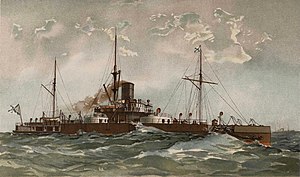
Back Pjotr Weliki (Schiff, 1876) German آیرونکلاد پتر ولیکی Persian Pierre le Grand (cuirassé) French ピョートル・ヴェリーキー (戦艦) Japanese Piotr Wielikij (1872) Polish Пётр Великий (броненосец) Russian Pjotr Velikij (1872) Swedish
 An 1893 lithograph of Petr Veliky
| |
| History | |
|---|---|
| Name | Petr Velikiy |
| Namesake | Peter the Great |
| Operator | Imperial Russian Navy |
| Builder | Galerniy Island Shipyard, Saint Petersburg |
| Cost | over 5.5 million rubles |
| Laid down | 23 July 1870[Note 1] |
| Launched | 27 August 1872 |
| Decommissioned | 21 May 1921 |
| In service | 14 October 1876 |
| Renamed |
|
| Reclassified |
|
| Stricken | 18 April 1959 |
| Fate | Scrapped after April 1959 |
| General characteristics (as built) | |
| Type | Turret ship |
| Displacement | 10,406 long tons (10,573 t) |
| Length | 333 ft 8 in (101.7 m) |
| Beam | 63 ft (19.2 m) |
| Draft | 24 ft 9 in (7.5 m) (designed) |
| Installed power | |
| Propulsion | 2 shafts; 2 horizontal-return, connecting rod-steam engines |
| Speed | about 13 knots (24 km/h; 15 mph) |
| Range | 2,900 nautical miles (5,400 km; 3,300 mi) at 10 knots (19 km/h; 12 mph) |
| Complement | 24 officers and 417 crewmen |
| Armament |
|
| Armor |
|
Petr Velikiy (Russian: Пётр Великий – Peter the Great) was an ironclad turret ship built for the Imperial Russian Navy during the 1870s. Her engines and boilers were defective, but were not replaced until 1881. The ship made a cruise to the Mediterranean after they were installed, and before returning to the Baltic Fleet, where she remained for the rest of her career. She did not, like the rest of the Baltic Fleet, participate in the Russo-Turkish War of 1877–1878. Petr Veliky was deemed obsolete by the late 1890s, but she was not ordered to be converted into a gunnery training ship until 1903.
The Russo-Japanese War of 1904–1905 slowed her reconstruction, and the ship was not completed until 1908. She spent most of World War I as a training ship, although she became a depot ship for submarines in 1917. Petr Veliky was in Helsinki in March 1918 when the Treaty of Brest-Litovsk required the Soviets to evacuate their naval base at Helsinki or have their ships interned by newly independent Finland even though the Gulf of Finland was still frozen over. The ship reached Kronstadt in April 1918 and was hulked on 21 May 1921. She remained in service with the Soviets, in various secondary roles, until she was finally stricken from the Navy List in 1959 and subsequently scrapped.
Cite error: There are <ref group=Note> tags on this page, but the references will not show without a {{reflist|group=Note}} template (see the help page).